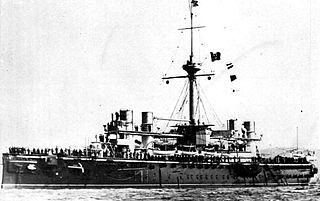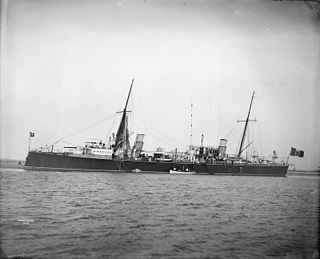This page is based on this
Wikipedia article Text is available under the
CC BY-SA 4.0 license; additional terms may apply.
Images, videos and audio are available under their respective licenses.

Re Umberto was a Re Umberto-class ironclad battleship built for the Italian Regia Marina in the 1880s, the lead ship of her class. She was laid down in July 1884 and launched in October 1888; work proceeded so slowly that she was not finished until February 1893. She was armed with a main battery of four 13.5-inch (340 mm) guns and had a top speed of 20.3 knots, though this high speed came at the cost of armor protection.

Sardegna was the third of three Re Umberto-class ironclad battleships built for the Italian Regia Marina. The ship, named for the island of Sardinia, was laid down in La Spezia in October 1885, launched in September 1890, and completed in February 1895. She was armed with a main battery of four 13.5-inch (340 mm) guns and had a top speed of 20.3 knots —albeit at the cost of armor protection—and she was one of the first warships to be equipped with a wireless telegraph.

Italia was an Italian ironclad battleship build for the Italian Regia Marina, the lead ship of the Italia class. She and her single sister ship, Lepanto, had lengthy construction times. Italia was laid down in January 1876, launched in September 1880, and completed in October 1885. She was armed with a main battery of four 17 in (432 mm) guns mounted in a central barbette and was capable of a top speed of 17.8 knots. Unusually, for ships of that era, Italia had an armored deck rather than the typical belt armor.

Lepanto was an Italian ironclad battleship built for the Italian Regia Marina, the second and last ship of the Italia class. Lepanto was laid down in November 1876, launched in March 1883, and completed in August 1887. She was armed with a main battery of four 17 in (432 mm) guns mounted in a central barbette and was capable of a top speed of 17.8 knots. Unlike other capital ships of the era, Lepanto had an armored deck rather than the more typical belt armor.

Francesco Morosini was an ironclad battleship built in the 1880s and 1890s for the Italian Regia Marina. The ship, named for Francesco Morosini, the 17th-century Doge of Venice, was the second of three ships in the Ruggiero di Lauria class, along with Ruggiero di Lauria and Andrea Doria. She was armed with a main battery of four 17-inch (432 mm) guns, was protected with 17.75-inch (451 mm) thick belt armor, and was capable of a top speed of 17 knots.

Andrea Doria was an ironclad battleship built for the Italian Regia Marina in the 1880s and 1890s. Named for the 16th-century Genoese admiral Andrea Doria, she was the third and final ship of the Ruggiero di Lauria class. The ship was armed with a main battery of four 17-inch (432 mm) guns, was protected with 17.75-inch (451 mm) thick belt armor, and was capable of a top speed of 17 knots.

The Francesco Morosini Naval Military School is a military education college based in Venice operated by the Italian Navy and named after the great venetian Doge.

Partenope was a torpedo cruiser built for the Italian Regia Marina in the 1880s, the lead ship of her class, which included seven other vessels. The ship was built by the Regio Cantiere di Castellammare di Stabia; she was laid down in June 1888, was launched in December 1889, and was completed in September 1890. Her main armament were her five torpedo tubes, which were supported by a battery of ten small-caliber guns.

Calatafimi was a torpedo cruiser of the Partenope class built for the Italian Regia Marina in the 1880s. She was built by the Cantiere navale fratelli Orlando shipyard; her keel was laid in July 1891, she was launched in May 1894, and was commissioned in December 1895. Her main armament were her five torpedo tubes, which were supported by a battery of eleven small-caliber guns. Calatafimi spent most of her career in the main Italian fleet, where she was primarily occupied with training exercises. The ship was sold in March 1907 and broken up for scrap.

Folgore was a torpedo cruiser built for the Italian Regia Marina, the lead ship of the Folgore class. Armed with three 14 in (356 mm) torpedo tubes and six light guns, she was capable of a top speed of 17 knots. She was built in the mid-1880s, was launched in September 1886, and was completed in February 1887. The ship spent her first two years in service either conducting training maneuvers with the main Italian fleet or in reserve status. She was badly damaged in a collision with the cruiser Giovanni Bausan in 1889, which reduced her effectiveness and cut her career short. Folgore spent the next eleven years primarily in the reserve, until she was sold for scrap in April 1901 and broken up.

Goito was a torpedo cruiser built for the Italian Regia Marina in the 1880s. She was the lead ship of the Goito class, which included three other vessels. Goito was built by the Regio Cantiere di Castellammare di Stabia shipyard between September 1885 and February 1888. She was armed with a variety of light guns and five 14-inch (356 mm) torpedo tubes, and was capable of a top speed of 18 knots. The ship served the duration of her career in the main Italian fleet. Her early service was primarily occupied with training exercises; front-line duties ended in 1897 when she was converted into a minelayer, though she continued to participate in fleet exercises. During World War I, Goito laid defensive minefields in the Adriatic Sea. She was eventually sold for scrap in 1920 and broken up.

Monzambano was a torpedo cruiser of the Goito class built for the Italian Regia Marina in the 1880s. The ship was built at the Arsenale di La Spezia, beginning with her keel laying in August 1885 and ending with her completion in August 1889. She was armed with a variety of light guns and five 14-inch (356 mm) torpedo tubes, and was capable of a top speed of 18 knots. The ship spent her career in the main Italian fleet conducting training exercises, and did not see action. She spent 1898 patrolling the eastern Mediterranean Sea with the Levant Squadron. Monzambano was withdrawn from service in 1901 and broken up for scrap that year.
Lauria is an Italian town and comune of the province of Potenza, in Basilicata, situated near the borders of Calabria.
The Cannon 152/32 Model 1887 was an Italian naval gun designed by the Elswick Ordnance Company and produced by Armstrong Whitworth in the late 1880s for the Italian Navy.













